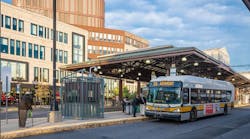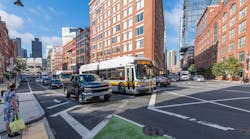MBTA launches Bus Priority Vision and Toolkit
The Massachusetts Bay Transportation Authority (MBTA) has launched its Bus Priority Vision and Toolkit. Through partnerships with communities and municipalities, the Bus Priority Vision and Toolkit will allow the MBTA to make bus transit faster and more efficient through the creation of dedicated bus lanes, the implementation of transit signal priority and the use of queue jumps.
The Bus Priority Vision and Toolkit are two new complementary resources that are designed to support the expansion of bus priority investments throughout the region over the next five to seven years. They provide guidance to municipal, state and transit staff on planning and implementing bus priority treatments to encourage more regional transit use.
“Our long-term vision for regional bus priority investments is now available for the first time ever. We are showing how joint investments in street improvements with our municipal and state partners can create the changes we need to better serve our bus riders,” said MBTA General Manager and CEO Phillip Eng. “As part of this, ensuring robust public engagement is integral to the decision to rebuild and grow bus service for the Commonwealth. As congestion has increased across the region, it’s clear investments in projects like bus lanes will keep people moving reliably and these initiatives reaffirm the MBTA’s commitment to making the bus better for more people. This vision, along with the Network Redesign, is our plan to rebuild and grow bus service.”
The plan consists of a regional network of 26 bus corridors with high ridership and frequency that will have significant benefits from bus priority treatments such as bus-only lanes, transit signal priority and improved bus stops. MBTA says implementing the measures will improve bus service reliability and reduce travel delays. The improvements will benefit around 220,000 daily bus riders, which accounts for 80 percent of bus riders. The plan is aligned with the MBTA's Bus Network Redesign, which was approved by the MBTA Board of Directors in late 2022. The redesign will update the bus network to better serve the region’s mobility needs and address changing travel patterns, traffic congestion, changing demographics and access to housing and jobs.
The toolkit is designed to provide a consistent approach to planning and implementing bus priority treatments that cater to local community needs within the MBTA region. It draws from best practices at local and national levels, summarizes past project experiences and outlines the benefits, tradeoffs and considerations of effectively using limited road space. These improvements lead to a better rider experience, increased ridership, reduced vehicles on the road and lower transportation-related emissions.
“Bus prioritization improves the rider experience. We have worked closely with the MBTA to ensure that bus riders are able to move more quickly on high-delay corridors like Washington Street in Roslindale or Summer Street in the Seaport,” said Boston Chief of Streets Jascha Franklin-Hodge. “We look forward to continuing our partnership with the MBTA to create a regional transit system that is reliable, equitable and accessible to everyone who lives, works and visits Boston.”
“We have long advocated for the MBTA and municipalities to prioritize bus riders and are thrilled to celebrate the release of the Bus Priority Vision and Toolkit,” said Executive Director of LivableStreets Stacy Thompson. “Only five years ago, there were fewer than five miles of bus lanes on local streets. Thanks to the MBTA’s dedication to improving its bus system, the leadership of cities and towns, and the support of advocates, that bus priority network has grown ten-fold. Together, the Bus Priority Vision and the Toolkit are testaments to how far we’ve come as a region while also providing us with a roadmap for how to ensure the MBTA provides riders with the best bus service in the country.”
Since 2018, approximately 50 miles of bus lanes have been constructed. The Bus Priority Vision identifies an additional 60 miles of roadway for targeted transit improvements. Bus priority measures have been implemented or are currently being planned in coordination with the MBTA and municipal and state partners across 14 municipalities, including Arlington, Boston, Brookline, Cambridge, Chelsea, East Boston, Everett, Lynn, Revere and Somerville.
The Barr Foundation provided funding to develop the MBTA’s Bus Priority Vision and Toolkit, which is integral to the MBTA's Better Bus Project. The Better Bus Project's goal is to enhance, expand and electrify bus services. This includes the Fleet and Facility Modernization program, the Bus Network Redesign and other related initiatives.




